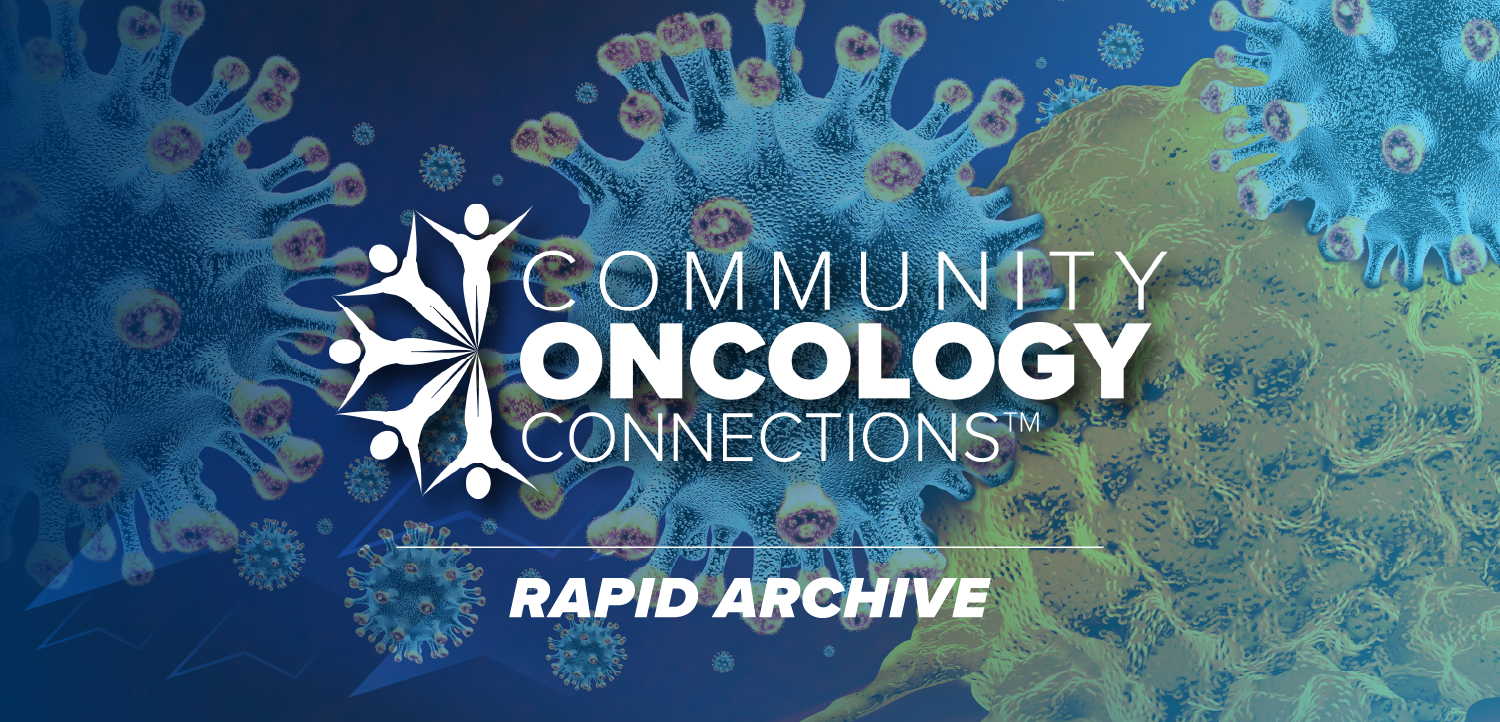
- ONCOLOGY Vol 39, Issue 3
- Volume 39
- Issue 3
- Pages: 124-127
3 Things You Should Know About Individualizing Care for Patients With Epithelioid Sarcoma
Personalized therapeutic approaches and novel, targeted medicines can help patients with epithelial sarcoma attain better survival outcomes.
RELEASE DATE: April 1, 2025
EXPIRATION DATE: April 1, 2026
LEARNING OBJECTIVES
Upon successful completion of this activity, you should be better prepared to:
- Describe the unique features of epithelioid sarcoma (ES) to improve diagnostic accuracy
- Design optimal treatment plans for people with ES based on the efficacy and safety of new and current treatment options
Accreditation/Credit Designation
Physicians’ Education Resource®, LLC, is accredited by the Accreditation Council for Continuing Medical Education (ACCME) to provide continuing medical education for physicians.
Physicians’ Education Resource®, LLC, designates this enduring material for a maximum of 0.25 AMA PRA Category 1 Credits™. Physicians should claim only the credit commensurate with the extent of their participation in the activity.
Acknowledgment of commercial support
This activity is supported by an educational grant from Ipsen Biopharmaceuticals, Inc.
Off-label disclosure/disclaimer
This activity may or may not discuss investigational, unapproved, or off-label use of drugs. Learners are advised to consult prescribing information for any products discussed. The information provided in this activity is for accredited continuing education purposes only and is not meant to substitute for the independent clinical judgment of a health care professional relative to diagnostic, treatment, or management options for a specific patient’s medical condition. The opinions expressed in the content are solely those of the individual faculty members, and do not reflect those of PER or any company that provided commercial support for this activity.
Instructions for participation/how to receive credit
- Read this activity in its entirety.
- Go to
https://www.gotoper.com/sbnspes25-postref to access and complete
the posttest. - Answer the evaluation questions.
- Request credit using the drop-down menu.
YOU MAY IMMEDIATELY DOWNLOAD YOUR CERTIFICATE.
Epithelioid sarcoma (ES) is a rare form of soft tissue sarcoma (STS), accounting for fewer than 1% of STS cases.1 The disease is known for being difficult to treat, with high rates of local recurrence (34%-77%) and metastasis (~ 40%).2 Modern cancer treatment is typically individualized based on disease characteristics and patient factors, and the management of ES is no exception. By developing a personalized therapeutic approach and incorporating novel, targeted medications, providers today can better achieve the goals of improving survival and reducing undesirable outcomes in patients with ES. Here are 3 things you should know about individualizing care for patients with ES.
1. Many disease characteristics factor into an individualized therapeutic approach for ES.
Managing a case of ES begins with proper diagnostic workup, disease staging, and the formation of an experienced multidisciplinary team. Classic or distal-type ES is the more common form, and it typically presents as a painless, flesh-colored mass located on the distal aspect of an extremity. There may be ulceration, bleeding, or necrosis overlying the mass.1,2 Proximal-type ES is rarer and more aggressive but presents in a similar way, except the mass can be found more proximally on the limb or on the pelvis or trunk.3 The differential diagnosis for ES includes various other STS subtypes, such as malignant peripheral nerve sheath tumor, synovial sarcoma, and malignant rhabdoid tumor.1,3 A proper diagnostic and staging workup for ES includes x-rays, an MRI with contrast, an examination of locoregional lymph nodes, a chest X-ray or chest CT, and a tissue biopsy (Figure 1).3 It is highly important that a team of knowledgeable clinicians (including a medical oncologist, orthopedic surgeon, pathologist, and radiation oncologist) is involved in the care planning as early as possible, preferably prior to biopsy.4,5
Developing an appropriate treatment plan for ES involves the consideration of many factors, including the stage of the tumor, as well as the age, comorbidities, and functional demands of the patient. As with most other types of STS, the preferred treatment for ES in most cases consists of a wide surgical excision with perioperative radiation to reduce the risk of local recurrence.4,5 Unfortunately, sometimes limb-sparing tumor excision is not possible, necessitating amputation; however, this is an instance in which shared decision-making and a discussion of the risks and benefits of treatment are rather important. Systemic treatment for ES is usually reserved for advanced or recurrent cases involving local spread or metastasis.4,5
2. An understanding of the molecular basis for ES leads to more specific systemic treatments.
As was mentioned above, ES has many clinical features in common with other types of STS, and it is often differentiated based on an analysis of molecular and/or genetic factors. One key defining aspect of ES is the near-universal loss of function of the integrase interactor 1 enzyme (INI1). Immunohistochemical analysis of tissue samples has revealed that over 90% of ES tumors show such a loss of function, regardless of subtype.1,6 The SMARCB1 gene on chromosome 22 encodes INI1, though in many cases of ES, the gene is unaffected, suggesting posttranscription silencing.1 Other molecular features of ES include the presence of vimentin, cytokeratin, and epithelial membrane antigen, though these are nonspecific markers. Approximately half of ES tumors express CD34 and CA125, the latter of which can sometimes be used as a blood test to track the disease’s response to treatment.6
Traditional chemotherapies historically used in the treatment of ES, such as anthracycline, gemcitabine, and/or ifosfamide, do not target cancerous cells specifically. This is due to commonalities in the mechanisms of action of such medications—they each work in some capacity by impairing the process of DNA replication necessary for cell division. Although this is effective in hindering a tumor’s ability to grow, it can also have a negative impact on other cell lines in the body that divide rapidly, such as intestinal epithelial or bone marrow cells. This is consistent with evidence showing high rates of adverse events in patients with ES receiving traditional chemotherapy.7
Given the ubiquity of the loss of INI1 function in ES, it should come as no surprise that the enzyme was identified as a promising target for drug development. INI1 is a tumor suppressor that inhibits the enhancer of zeste homolog 2 (EZH2) enzyme, indirectly stimulating the transcription of other tumor suppressor genes.8 Tazemetostat, a targeted medication that works as a novel inhibitor of EZH2, was developed based on an understanding of the molecular biology of ES.
3. Targeted systemic treatment for ES is effective alone and has promise in combination therapy.
Treatment with the targeted medication tazemetostat was successful in a phase 2 clinical trial (Figure 2).9 The results of that study led to FDA approval for the medication in 2020, and a granting of orphan drug status for the treatment of ES. Moreover, updated NCCN guidelines have listed tazemetostat as a preferred treatment for advanced, recurrent, or metastatic ES.4 Encouraging initial clinical results for tazemetostat alone have also led to it being currently investigated for use as part of a combined therapeutic regimen, along with doxorubicin.10
Key References
3. Guillou L, Wadden C, Coindre JM, Krausz T, Fletcher CD. “Proximal-type” epithelioid sarcoma, a distinctive aggressive neoplasm showing rhabdoid features: clinicopathologic, immunohistochemical, and ultrastructural study of a series. Am J Surg Pathol. 1997;21(2):130-146. doi:10.1097/00000478-199702000-00002
6. Hornick JL, Dal Cin P, Fletcher CD. Loss of INI1 expression is characteristic of both conventional and proximal-type epithelioid sarcoma. Am J Surg Pathol. 2009;33(4):542-550. doi:10.1097/PAS.0b013e3181882c54
9. Gounder M, Schöffski P, Jones RL, et al. Tazemetostat in advanced epithelioid sarcoma with loss of INI1/SMARCB1: an international, open-label, phase 2 basket study.Lancet Oncol. 2020;21(11):1423-1432. doi:10.1016/S1470-2045(20)30451-4
For full reference list visit
CME Posttest Questions
1. SA is a 24-year-old man who presents with a history of a slowly enlarging mass on the medial aspect of his forearm near the wrist, which gradually increased in size and became uncomfortable. MRI of the region demonstrates a well-defined soft tissue nodule within the subcutaneous tissues, measuring up to 4.4 cm. Biopsy confirms a diagnosis of epithelioid sarcoma. A PET scan reveals an 18F-fluorodeoxyglucose—avid mass at the primary site and ipsilateral, mildly hypermetabolic, minimally enlarged axillary lymph nodes measuring up to 1.4 cm, and no evidence of distant metastasis is identified. Results of routine laboratory investigations are within normal limits.
What is the next step in the management of SA’s condition?
A. Repeat imaging in 6 to 8 weeks to assess the disease’s progression.
B. Resect the primary tumor with axillary lymph node biopsy and/or dissection.
C. Order an MRI of the brain.
D. Initiate palliative chemotherapy.
2. After undergoing primary tumor resection with lymph node dissection, the tumor is fully excised with negative margins, but 2 of 8 lymph nodes are
positive for sarcoma. Imaging surveillance shows no evidence of disease for
9 months. Follow-up CT scans reveal over 10 pulmonary nodules that measure up to 2 cm in size and a recurrence of the primary tumor at the surgical scar. A transbronchial biopsy confirms metastatic epithelioid sarcoma.
After confirming a diagnosis of epithelioid sarcoma, what is the most
appropriate next step for managing SA’s epithelioid sarcoma?
A. Consider enrollment in a clinical trial, and initiate systemic chemotherapy specific to epithelioid sarcoma.
B. Perform radiation therapy targeting the largest pulmonary nodules.
C. Repeat resection of the recurrent primary tumor.
D. Refer to the section of palliative care for symptom management without additional treatment.
Claim Your CME Credit at
To learn more about this topic, including information on the pathology and histology of epithelioid sarcoma, go to
CME Provider Contact information
Physicians’ Education Resource®, LLC
2 Commerce Drive, Suite 110, Cranbury, NJ 08512
Toll-Free: 888-949-0045
Local: 609-378-3701
Fax: 609-257-0705
info@gotoper.com
Articles in this issue
Newsletter
Stay up to date on recent advances in the multidisciplinary approach to cancer.


















































































